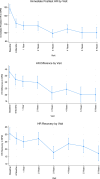Functional mobility and pain are improved for 6 years after adolescent bariatric surgery
- PMID: 40259728
- PMCID: PMC12119214
- DOI: 10.1002/oby.24285
Functional mobility and pain are improved for 6 years after adolescent bariatric surgery
Abstract
Objective: The long-term durability of improvements in functional mobility and musculoskeletal pain for adolescents after metabolic and bariatric surgery (MBS) is unknown.
Methods: We used the Teen-Longitudinal Assessment of Bariatric Surgery (Teen-LABS) study to determine the change in mobility and pain among adolescents who underwent MBS. From standardized 400-m walk tests, we analyzed walk time, heart rate (HR) parameters, and musculoskeletal pain.
Results: The mean walk time improved from 383 s (95% CI: 368-399) prior to surgery to 351 s (95% CI: 330-372) by 6 years. The mean resting HR was 90 beats per minute (bpm; 95% CI: 87-93) preoperatively and decreased to 80 bpm (95% CI: 76-84) by 6 years. The risk of any musculoskeletal pain decreased from 37.2% (95% CI: 25.5%-48.9%) to 11.0% (95% CI: 4.3%-17.6%) by 6 years. Mediation analysis revealed that the effect of time since surgery on walk time, resting HR, and HR recovery occurred through a weight-dependent mechanism. For posttest HR and HR difference, there was both a significant weight-dependent and weight-independent mechanism. The effect of surgery on the risk of musculoskeletal pain occurred through a weight-independent mechanism.
Conclusions: Adolescents who underwent MBS experienced significant, durable improvement in mobility and pain, despite weight regain. Our models suggest that improvements may occur through a weight-independent mechanism.
© 2025 The Author(s). Obesity published by Wiley Periodicals LLC on behalf of The Obesity Society.
Conflict of interest statement
Justin R. Ryder receives support from Boehringer Ingelheim Pharmaceuticals in the form of drugs and placebos. Stephanie Sisley has received speaking and consulting fees from Rhythm Pharmaceuticals that are unrelated to this project. Marc P. Michalsky has received educational honoraria from Intuitive Surgical, Inc., and serves on a pediatric obesity advisory panel for Eli Lilly and Company, both unrelated to this project. Thomas H. Inge has served as consultant for Standard Bariatrics and Independent Medical Expert Consulting Services, both unrelated to this project. Anita P. Courcoulas has research support from Allurion Technologies and Eli Lilly and Company. The other authors declared no conflicts of interest.
Figures




Similar articles
-
Changes in Functional Mobility and Musculoskeletal Pain After Bariatric Surgery in Teens With Severe Obesity: Teen-Longitudinal Assessment of Bariatric Surgery (LABS) Study.JAMA Pediatr. 2016 Sep 1;170(9):871-7. doi: 10.1001/jamapediatrics.2016.1196. JAMA Pediatr. 2016. PMID: 27429076 Free PMC article.
-
Musculoskeletal Pain, Self-reported Physical Function, and Quality of Life in the Teen-Longitudinal Assessment of Bariatric Surgery (Teen-LABS) Cohort.JAMA Pediatr. 2015 Jun;169(6):552-9. doi: 10.1001/jamapediatrics.2015.0378. JAMA Pediatr. 2015. PMID: 25915190 Free PMC article.
-
Musculoskeletal Pain, Physical Function, and Quality of Life After Bariatric Surgery.Pediatrics. 2019 Dec;144(6):e20191399. doi: 10.1542/peds.2019-1399. Epub 2019 Nov 19. Pediatrics. 2019. PMID: 31744891 Free PMC article.
-
Assessment and medical management of weight regain after adolescent metabolic and bariatric surgery: a narrative review.Surg Obes Relat Dis. 2025 Jan;21(1):24-32. doi: 10.1016/j.soard.2024.10.008. Epub 2024 Oct 12. Surg Obes Relat Dis. 2025. PMID: 39609232 Review.
-
Bariatric Surgery in Children: Indications, Types, and Outcomes.Curr Gastroenterol Rep. 2019 Apr 25;21(6):24. doi: 10.1007/s11894-019-0691-8. Curr Gastroenterol Rep. 2019. PMID: 31025124 Review.
References
-
- Ryder JR, Fox CK, Kelly AS. Treatment options for severe obesity in the pediatric population: current limitations and future opportunities. Obesity (Silver Spring). 2018;26(6):951‐960. - PubMed
-
- Kelly AS, Barlow SE, Rao G, et al. Severe obesity in children and adolescents: identification, associated health risks, and treatment approaches: a scientific statement from the American Heart Association. Circulation. 2013;128(15):1689‐1712. - PubMed
MeSH terms
Grants and funding
LinkOut - more resources
Full Text Sources
Medical

